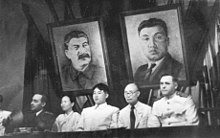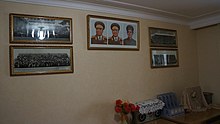Hiko Funny Picture Kim Jon I


Visual depictions of Kim Il-sung have been commonplace in North Korea since the 1940s following the example of Joseph Stalin in the Soviet Union and Mao Zedong in China. The display of Kim Il-sung portraits was fabricated mandatory at homes in the 1970s. In the by, they were mandatory in certain public places besides, such as factories, airports, railway stations, and rails and subway carriages. At present, they no longer appear in means of transprt, not even in some new buildings. Portraits of Kim Jong-il accept been hung adjacent to Kim Il-sung since the belatedly 1970s. A portrait of Kim Jong-un was displayed for the first time in public in 2018.
Rules regarding the placement and maintenance of the portraits are circuitous and change often. At homes, they should be placed on the about prominent wall in the living room with zilch else on it, at loftier and looking down. Of importance, and subject field to random checks, is that they are kept clean, a responsibility that usually falls on the lady of the house.
History [edit]



Since the 1940s visual depictions of Kim Il-sung have been commonplace in Northward Korea.[1] The practice was adopted from Stalin portraits in the Soviet Union and portraits of Mao Zedong in China.[ii] Displaying a portrait of Kim Il-sung in every house became mandatory in the 1970s. The country distributed such portraits and instructed people to display them in their living rooms.[3] Past Kim Il-sung's 60th altogether in 1972, Democratic people's republic of korea had more leader portraits than the Soviet Matrimony or China always did.[2] In 1972, the compulsory display of the portraits was extended to all factories, airports, and railway stations.[3]
At the cease of the decade, North Koreans were told to hang portraits of Kim Jong-il next to their portraits of Kim Il-sung.[3] The regulation was put in place relatively late into Kim Jong-il's cult of personality.[4] The reason was that he had little, and by 1980 virtually no, competition as the heir credible.[v] The guild to exercise so became unofficially and then that North Korean propaganda could claim that there was a spontaneous move that supported Kim Jong-il. Past around 1980, every role and home had the ii portraits on display.[6] In the 1980s, the rules on portraits were extended however once more to cover track and subway carriages. Buses and trams were excluded for unknown reasons.[three] Since the early 1990s, Kim Jong-il portraits have been the same size as those depicting Kim Il-sung, and their brandish has been standardized so that they are always displayed side by side.[2] In the 1990s, a third kind of portrait was added that depicts Kim Jong-il and Kim Il-sung engaged in discussion near land management. High-ranking officials were given still another portrait, that of Kim Il-sung'south first wife and mother of Kim Jong-il, Kim Jong-suk. Offices, however, practise not display this picture.[3] In contempo years, the portraits' societal importance has waned.[vii]
The epitome of Kim Il-sung underwent changes equally he anile and according to political currents: early portraits from the 1960s accept him in a Mao conform, while those from the 1980s depict him in a Western arrange. Years later on his decease, he began to appear in the military uniform of Taewonsu (generalissimo). Images of Kim Jong-il, besides, went from Mao adjust to the Taewonsu uniform.[two]
Under Kim Jong-un, the appearances of the portraits have become increasingly standardized.[8] The current versions of the portraits consists of Kim Il-sung in a western-style suit and Kim Jong-il wearing his trademark green jumpsuit.
A portrait of Kim Jong-un was displayed for the offset time in public in Nov 2018 during a visit of Cuban president Miguel Díaz-Canel to Pyongyang.[ix]
Andrei Lankov, an practiced on Democratic people's republic of korea, notes that the prepare of rules regarding the portraits changes frequently, making information technology "remarkable for its constant fluidity".[ten]
Display [edit]
Today, the portraits are found everywhere in North korea.[2] Rules regarding the brandish and maintenance of the portraits are circuitous.[six] The portraits should be hung on the almost prominent wall of the apartment with zilch else on it,[11] preferably in the living room.[2] They must be kept clean and may not exist hung off-center.[12] Any disrespect to the images of the leaders is criminal. This includes not just portraits hung on walls but also due east.grand. images in newspapers.[13] Damage to the portraits leads to an investigation and, if the suspect is plant guilty, punishment.[half-dozen] A penalty of 1 day of hard labor at a construction site is reported for failure to properly hang the portraits.[seven] The portraits are to be protected even in the example of an emergency.[fourteen] All the same, neglecting care for the portraits is considered a rather pocket-size offense, and every bit such, it is a typical confession that people brand during mutual criticism sessions.[fifteen] Random checks for the portraits are carried out,[10] monthly at least during Kim Il-sung's reign,[16] merely the inminban (neighborhood lookout man) sometimes tips people off of inspections.[7]
When a North Korean changes flat, he or she must start past hanging the portraits first.[x] The portraits are unremarkably hung on a wall with nothing else, placed high, and looking downwards. Some families bow to the portraits every morning and in the evening,[13] saying greetings,[17] even though bowing to them is not mandatory even in public places.[11] When a North Korean family unit mourns a dead member, ceremonial greetings and offerings are made to the deceased, just but after the two portraits have been given the aforementioned treatment.[17] The portraits are commonly kept clean by adults in the business firm, typically the mother of the family. They wipe the glass every morning time. Sometimes the portraits have a box under them that houses a white cloth used for dusting them that one is not allowed to apply for whatsoever other purpose.[17] [thirteen]
In addition to homes, offices, factories, shops, hospitals, classrooms and libraries sport the portraits,[13] equally practice decks of ships and fronts of trains.[xi] In public buildings they are placed above the main entrances.[2] All portraits are made past the Mansudae Art Studio. They are glazed and framed with timber.[two]
Safekeeping [edit]
Stories about North Koreans saving leader portraits from certain destruction have been sported in N Korean media for decades,[vi] and they have also been disseminated by the inminban.[eighteen] For case, in 2007 information technology was reported that a manufactory worker rescued his leader portraits and his five-year-old girl from a flooded firm. When he was overpowered by the water, he let go of his daughter but managed to agree onto the portraits.[14] Such a feat tin can enhance the societal status of a person considerably by improving their songbun (ascribed social rank in Democratic people's republic of korea).[19] Saving portraits is based on an capricious interpretation of the 10 Principles for the Institution of a Monolithic Ideological System.[eighteen]
Special portraits [edit]
In add-on to the standardized portraits, there have been special cases. One of these is a souvenir from the Syrian Arab Republic, a portrait of Kim Il-sung that is entirely fabricated upwards of Standard arabic calligraphy of his work The Non-Aligned Move is a Mighty Anti-Imperialist Revolutionary Forcefulness of Our Times, housed at the International Friendship Exhibition.[20] The largest Kim Il-sung portrait, at least in Pyongyang, was 15 by 11 meters and was hung at the Pyongyang Department Store No. 1 in the 1990s.[ii]
See too [edit]
- Kim Il-sung and Kim Jong-il badges
- Civilisation of North korea
- Listing of things named after Kim Il-sung
- North Korean cult of personality
- Guerrillero Heroico
- Portrait
- Mansu Loma Grand Monument
- Ge Xiaoguang
References [edit]
- ^ Lankov 2015, p. 35.
- ^ a b c d e f g h i Lankov 2007, p. 26.
- ^ a b c d e Lankov 2015, p. 35.
- ^ Cha 2012, p. 79.
- ^ Cha 2012, pp. 79, 87.
- ^ a b c d Lankov 2015, p. 53.
- ^ a b c Do et al. 2015, p. 238.
- ^ "Slogans of the 'Glorious State' mass games, in pictures". NK News. 13 September 2018. Retrieved fifteen September 2018.
- ^ "North Korea puts Kim Painting on Show for the first time". Channel NewsAsia. 6 November 2018. Retrieved 18 November 2018.
- ^ a b c Lankov 2007, p. 27.
- ^ a b c Hunter, Helen-Louise (1999). Kim Il-song's North korea. Westport: Praeger Publishers. p. 16. ISBN978-0-275-96296-8.
- ^ Cha 2012, p. eight.
- ^ a b c d Portal 2005, p. 87.
- ^ a b Lankov 2015, p. 36.
- ^ Lankov 2015, pp. 42–44.
- ^ Senker, Cath (2012). Democratic people's republic of korea and Republic of korea. New York: The Rosen Publishing Grouping. p. 12. ISBN978-1-4488-6072-2.
- ^ a b c Kwon, Heonik; Chung, Byung-Ho (2012). North korea: Beyond Charismatic Politics. Lanham: Rowman & Littlefield Publishers. p. 143. ISBN978-1-4422-1577-1.
- ^ a b Practise et al. 2015, p. 237.
- ^ Lankov 2015, p. 44.
- ^ Portal 2005, p. 95.
Works cited [edit]
- Cha, Victor (2012). The Incommunicable Country: N Korea, Past and Future. London: Random House. ISBN978-ane-4481-3958-3.
- Do, Kyung-ok; Kim, Soon-am; Han, Dong-ho; Lee, Keum-presently; Hong, Min (2015). White Paper on Human Rights in North korea 2015 (PDF). Seoul: Korea Institute for National Unification. ISBN978-89-8479-802-1. Archived from the original (PDF) on xx Feb 2018.
- Lankov, Andrei (2007). N of the DMZ: Essays on Daily Life in Democratic people's republic of korea. Jefferson: McFarland. ISBN978-0-7864-5141-eight.
- — (2015). The Existent North Korea: Life and Politics in the Failed Stalinist Utopia. Oxford: Oxford Academy Press. ISBN978-0-19-939003-viii.
- Portal, Jane (2005). Fine art Nether Command in North Korea. London: Reaktion Books. ISBN978-1-86189-236-2.
External links [edit]
- Photo of a set of portraits with the 3rd image of Kim Il-sung and Kim Jong-il discussing at Getty Images
Source: https://en.wikipedia.org/wiki/Kim_Il-sung_and_Kim_Jong-il_portraits
0 Response to "Hiko Funny Picture Kim Jon I"
Post a Comment